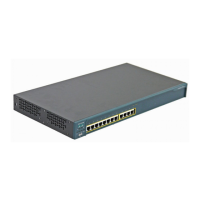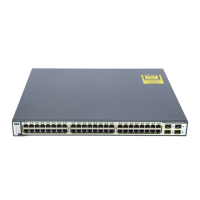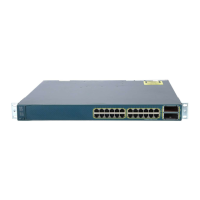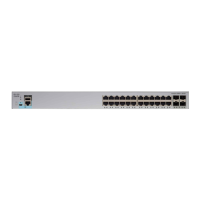52-13
Catalyst 6500 Series Switch Software Configuration Guide—Release 8.7
OL-8978-04
Chapter 52 Configuring QoS
Understanding How QoS Works
Marking at Untrusted Ports
QoS marks all frames that are received through the untrusted ports with the port CoS value (the default
is zero). QoS does not implement ingress port congestion avoidance on the untrusted ports. The traffic
goes directly to the switching engine.
Marking at Trusted Ports
When an ISL frame enters the switch through a trusted port, QoS accepts the three least significant bits
in the User field as a CoS value. When an 802.1Q frame enters the switch through a trusted port, QoS
accepts the User Priority bits as a CoS value. QoS marks all traffic that is received in the other frame
types with the port CoS value.
The port CoS value is configurable for each Ethernet port. For more information, see the “Configuring
the CoS Value for a Port” section on page 52-41.
Ethernet Ingress Port Scheduling and Congestion Avoidance
QoS does not implement ingress port congestion avoidance on the ports that are configured with the
untrusted, trust-ipprec, or trust-dscp keywords. The traffic goes directly to the switching engine.
QoS uses the CoS-value-based receive-queue drop thresholds to avoid congestion in the traffic that is
entering the switch through a port that is configured with the trust-cos keyword (for more information,
see the “Configuring the Trust State of a Port” section on page 52-41).
Receive Queues
Enter the show port capabilities command to see the queue structure of a port. The command displays
one of the following:
• rx-(1q8t) indicates one standard queue with eight configurable tail-drop thresholds.
• rx-(1q2t) indicates one standard queue with one configurable tail-drop threshold and one
nonconfigurable tail-drop threshold.
• rx-(1q4t) indicates one standard queue with four configurable tail-drop thresholds.
• rx-(1p1q4t) indicates one strict-priority queue and one standard queue with four configurable
tail-drop thresholds.
• rx-(1p1q0t) indicates one strict-priority queue and one standard queue with a nonconfigurable
threshold.
• rx-(1p1q8t) indicates one strict-priority queue and one standard queue with eight configurable
WRED-drop thresholds (on the 1p1q8t ports, the standard queue also has one nonconfigurable
tail-drop threshold).
Strict-priority queues are serviced in preference to other queues. QoS services the traffic in a
strict-priority queue before servicing the standard queue. When QoS services the standard queue, after
receiving a packet, it checks for the traffic in the strict-priority queue. If QoS detects the traffic in the
strict-priority queue, it suspends its service of the standard queue and completes the service of all traffic
in the strict-priority queue before returning to the standard queue.
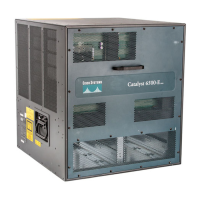
